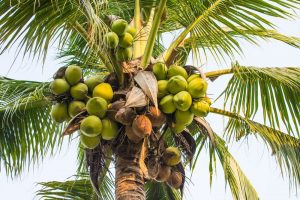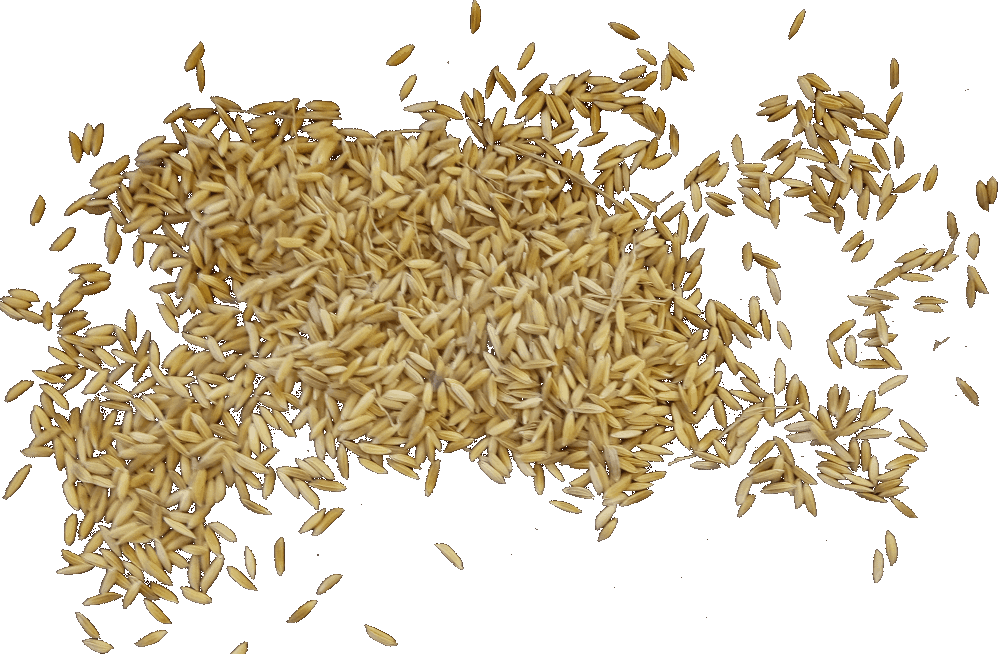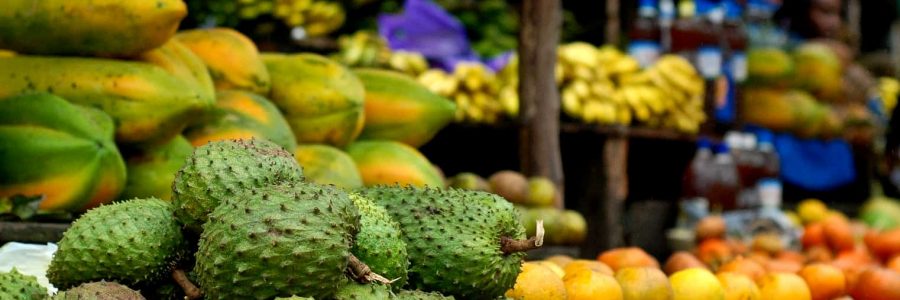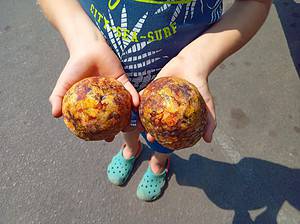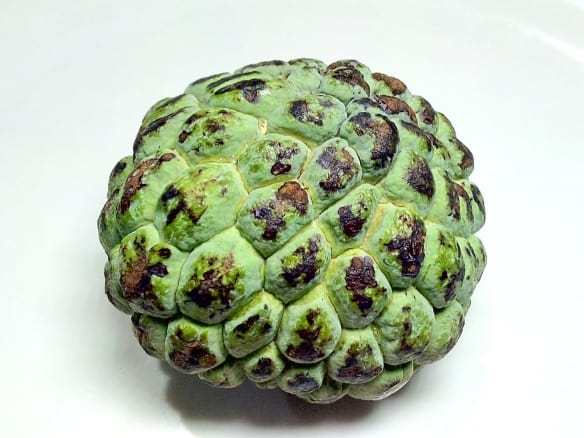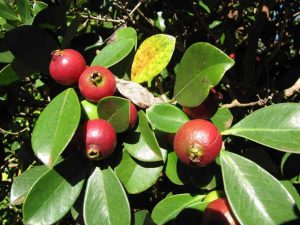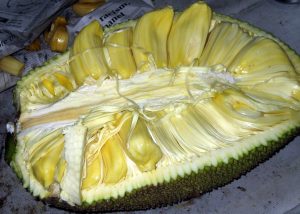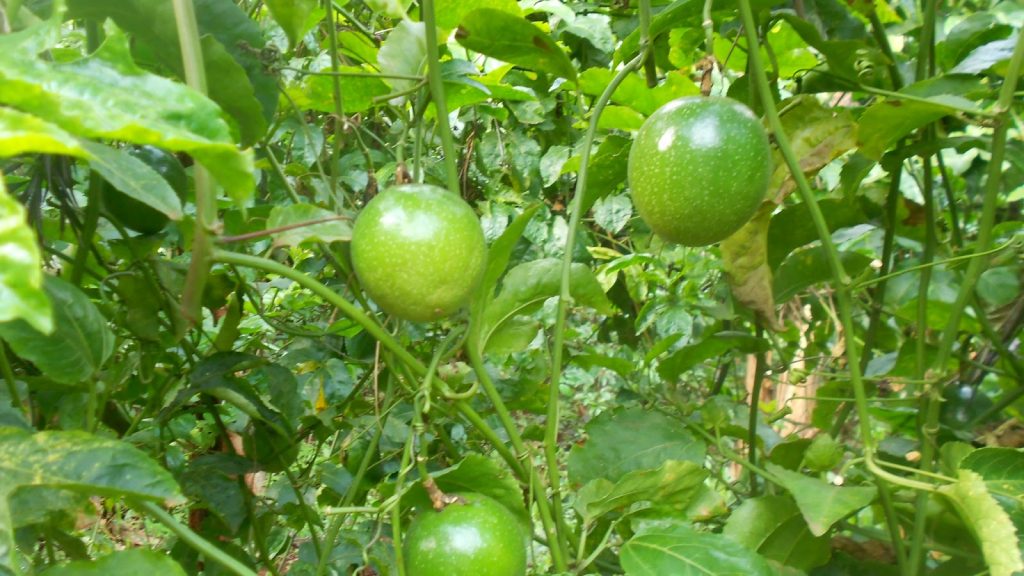Our village’s name is Maroamboka. It is located in the south-east of Madagascar between the coastal towns of Mananjary and Manakara. Our area is rich in coffee, vanilla and … fruit!
We have never eaten as many different fruits as here on Madagascar. That started when we lived in the capital, Antananarivo. But now, in Maroamboka, a large part of our diet consists of fruit. Vegetables, on the other hand, are scarce. We really have to leave the area in search of a good variety of vegetables.
For some time now we wanted to write a post about the fruit that we have at our disposal. We will also describe some fruits that we have encountered in our travels in Madagascar.
Along the way we will add more fruits because we hardly scratched the surface of all the fruits we have to our disposal.
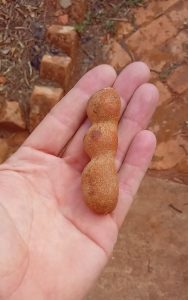
English: Tamarind
Malagasy: Madilo of Kily of Madir of kilendraza,
Dutch: Tamarinde
We had a Tamarind tree next to our house in Maroamboka. Unfortunately, it was blown over during a heavy cyclone. The fruits are often used to make juice (Jus Naturel). It is mixed with water and sugar. The pure fruit is extremely sour (at least the fruits we had were sour). We have also heard that people find them sweet. So maybe those are different kind.
https://nl.wikipedia.org/wiki/Tamarinde
https://en.wikipedia.org/wiki/Tamarind
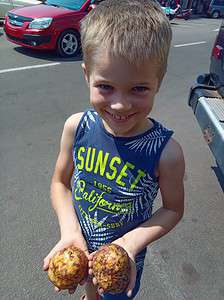
English: Not found yet.
Malagasy: Vonomby
Dutch: Not found yet.
This is a fruit we found at the market. When asked about the name we were given a common French name, which meant something like fruit of the cow(?!) The Malagasy name, ‘vonomby,’ means approximately the same. The taste is not strong, it is sweet and has a bit of a dry bite, it gives a dry feeling in your mouth.
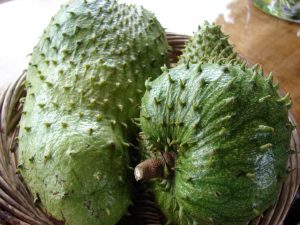 English: Soursop
English: Soursop
Malagasy: Corossol or Voantsokona
Dutch: Zuurzak
https://nl.wikipedia.org/wiki/Zuurzak
https://en.wikipedia.org/wiki/Soursop
This is a relative of the Sweetsop, but is not eaten in the same way. Here it is mainly used to make a really delicious fruit-drink, juice naturel. When in season, we eat them almost daily. They have a bit of a gumball flavour and are deliciously sweet/sour in taste.
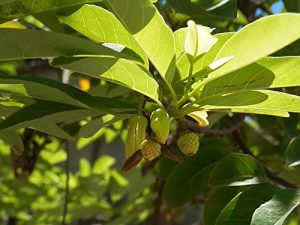 English: Custart apple, Sugar-apple or Sweetsop
English: Custart apple, Sugar-apple or Sweetsop
Malagasy: Pocanelle, Konikony, Voanjato or Voazato
Dutch: Zoetzak
https://nl.wikipedia.org/wiki/Zoetzak
https://en.wikipedia.org/wiki/Annona_squamosa
The Malagasy name, Voanjato, literally translates as ‘hundred seeds’. The fruit is creamy and filled with dozens of bean-sized black seeds. It’s a hassle to eat because you’re constantly busy spitting out all seeds, but once you start eating you can’t stop! Deliciously sweet with a bit of a vanilla pudding-like taste.
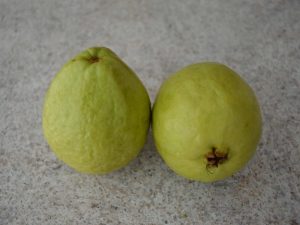 English: Guava
English: Guava
Malagasy: Goavy or Angavo
Dutch: Guava
https://en.wikipedia.org/wiki/Guava
I don’t know if there is a Dutch name for it, so we just call this fruit ‘Guava’ and in our village ‘Goavy’. You can eat the whole fruit and it has a sour taste. It is packed with small seeds that you just swallow. The Guavas come in two colors: yellow/green and reddish. The red ones below (English name: Strawberry apple) are a bit tougher but the taste seems the same.
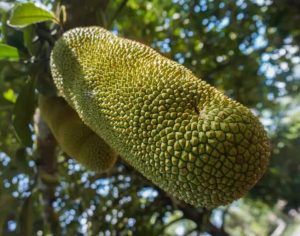 English: Jackfruit
English: Jackfruit
Malagasy: Apaly-be or Ampalibe
Dutch: Nanka or Jackfruit
https://nl.wikipedia.org/wiki/Nangka
https://en.wikipedia.org/wiki/Jackfruit
Jackfruits are the giants among the fruits. They can weigh up to 20 pounds each! Children climb the trees to cut down the fruit. Don’t stand underneath the tree when the fruit comes down. They often roll the fruits home. The road in front of our house is steep and you have to get out of the way when they bounce and roll down. The flesh is soft and the seeds (stones really) can be cooked and used for example in a salad. The Malagasy also cook the unripe fruit. The mush is then prepared with salt and eaten with rice. The fruits have a glue-like substance which looks and feels like wood glue. A horrible substance when it gets in your hair or on your clothes. We use a mix of salt and petroleum, to wash our hands to get rid of the sticky substance. Often the fruit ripens faster than we can eat it and then the taste becomes extremely sweet with a tingling effect on your tongue (alcohol).
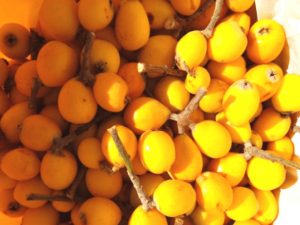 English: Loquat
English: Loquat
Malagasy: Pibasy
Dutch: Loquat
https://nl.wikipedia.org/wiki/Loquat
https://en.wikipedia.org/wiki/Loquat
This tree stood in our ‘backyard’. The flesh of this fruit is peach-coloured and they have a large shiny brown kernel. They have a slightly sour taste. We prefer to buy them when we see them during our travels or in the market. The tree behind our house was not such a success because the ants had made it their favourite workshop and they decided that nobody was allowed to come close.
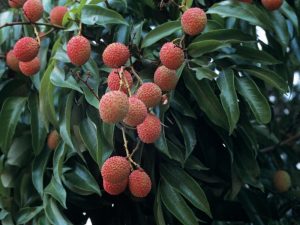 English: Lychee / Rambutan
English: Lychee / Rambutan
Malagasy: letchi
Dutch: Lychee / Ramboetan
https://nl.wikipedia.org/wiki/Lychee https://nl.wikipedia.org/wiki/Ramboetan
https://en.wikipedia.org/wiki/Lychee https://en.wikipedia.org/wiki/Rambutan
The taste is wonderful and almost addictive. Of course we knew the Lychees in the Netherlands as a luxury product, but here on Madagascar they grow just about everywhere. In season, late October till January, the market is flooded with them. They are cheap on the market (€ 0,75 per kilo), in our area we pay even less (for a large shopping bag full maybe only €0,25). Often we have to much and we have to tell people that we are not buying … There they are with their ‘goods’. No worries! We do not have to pay anything because at moments like that it is given to us as a gift. In addition to the regular Lychees, there are also the hairy Lychees (Rambutan). We don’t see them often in our area. They are a bit harder and less juicy and sweet.
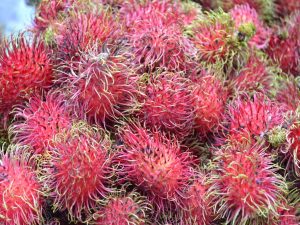
 English: Mango
English: Mango
Malagasy: Manga
Dutch: Mango
https://nl.wikipedia.org/wiki/Mango_(soort)
https://en.wikipedia.org/wiki/Mango
Mangoes come on the markets in December till January and, like most fruit, they are very cheap (€0,05/0,12 each in the cities). In our village we pay (if we have to pay) about €0,02 each. I’m not sure what variety of mango this is (there are a lot of varieties). In our area we mainly see the red/green Mangoes, but on the market we also find the yellow Mangoes.
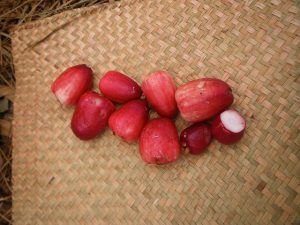 English: Mountain Apple
English: Mountain Apple
Malagasy: Makoba
Dutch: Djamboe bol, Maleisische rozenappel or Maleisische wasappel
https://nl.wikipedia.org/wiki/Djamboe_bol
https://en.wikipedia.org/wiki/Syzygium_malaccense
The taste of this fruit, originally from Malaysia, does not resemble an apple. The taste is a bit flat and dull. It is spongy and watery but they are good thirst quenchers. We eat these fruits especially when we are on the road. They are sold on the sides of the road. I have not yet seen them in our area.
 English: Passion-fruit
English: Passion-fruit
Malagasy: Giranadela
Dutch: Passievrucht
https://nl.wikipedia.org/wiki/Passiflora_edulis
https://en.wikipedia.org/wiki/Passiflora_edulis
We have two types of passion-fruit here: The larger one with the yellow skin and the slightly smaller one with a purple/reddish skin. The Malagasy likes to make it in to juice (Jus Naturel). Very nice when it is warm and you want a refreshing drink. The passion-fruit grows throughout our area. We have partially removed one behind our toilet. The passion-fruit grows on tendrils. These tendrils need other plants, shrubs and trees for support. If you let them grow they will soon cover everything and suffocate other vegetation. But oh boy, they are lovely (very sour, though) and the flowers are beautiful.
English: Papaya
Malagasy: Papay
Dutch: Papaja
https://nl.wikipedia.org/wiki/Papaja
https://en.wikipedia.org/wiki/Papaya
We don’t have many Papayas in our area, but every now and then we can get our hands on one. You can buy them everywhere in the bigger places. Our children are not so fond of them … I think we ate them a little too often. That started in 2015 when we attended a three weeks course in Kenya before flying on to Madagascar. Every meal (morning, afternoon and evening) there were Papayas. Once in Madagascar there were Papayas again! Sometimes we get Papaya as a gift. Fruits the size of a basketball. The children are polite and say ‘thank you’. Very well-mannered to the donors… then they say in Dutch: ‘Daaaddy, they have brought one again, what do you what me to do with it?’. Good thing the Malagasy don’t understand a word.
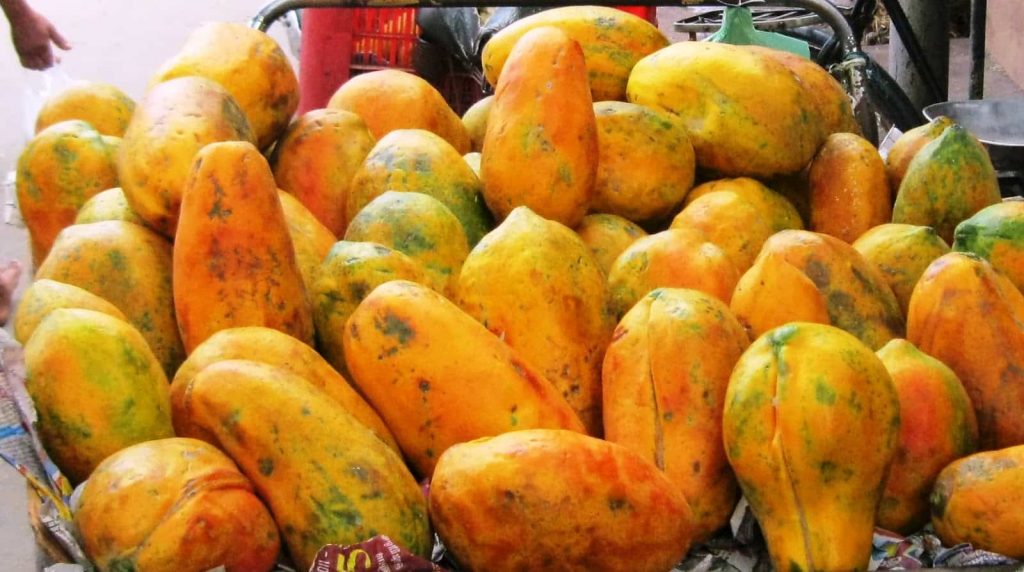
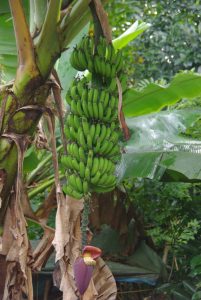 English: Banana
English: Banana
Malagasy: Akondro of fontsy
Dutch: Banaan
https://nl.wikipedia.org/wiki/Banaan_(vrucht)
https://en.wikipedia.org/wiki/Banana
Banana puree, banana bread, banana porridge, bananas on pizza, bananas in the spaghetti sauce, bananas … Everywhere! We have several banana trees next to the house. They grow fast and sometimes we need to cut them down because they are likely to fall down in Katja’s vegetable garden or on the roof of the washing place. We also buy bananas from people at the door, three large or six small for €0,02 all year round. We love them, and honestly, the taste so much better than the ones you buy in the supermarkets of Holland. You’ll have to come over and try them for yourself.
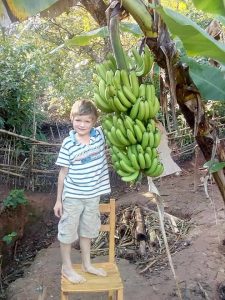
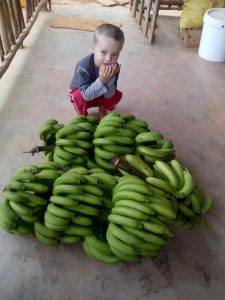
English: Avocado
Malagasy: Zavoka
Dutch: Avocado
https://nl.wikipedia.org/wiki/Avocado
https://en.wikipedia.org/wiki/Avocado
Just like the Papayas, we don’t have many Avocados growing in our area. The season runs from January to April. They are mostly available on the larger markets and cost about €0,10 each. This fruit is not a favourite among our children, but Katja and I love them (both the fruit and the children). They are also very healthy so we will buy them when we see them.
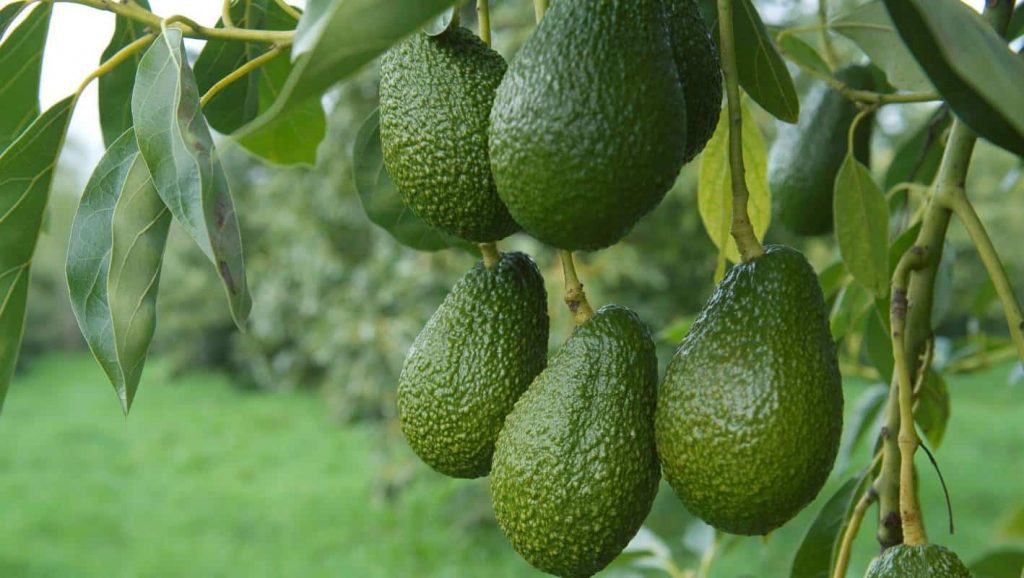
 English: Baobab
English: Baobab
Malagasy: Baobab
Dutch: Baobab
https://nl.wikipedia.org/wiki/Baobab
https://en.wikipedia.org/wiki/Adansonia
Since October 2019, these wonderful trees are growing in our area as well. On one of our trips to the capital, we came across the fruits. We had never had it before and at €0,20 per fruit we wanted to try it. The fruit has a hard, velvety exterior and is filled with seeds surrounded by dry, almost chalky flesh. The taste is a bit bland but we have heard that it is also used to make fruit juice (Jus Naturel). We have kept the seeds and grown them at home. Of the 40 seeds, 30 germinated and 4 have proven strong enough to withstand the attacks of snails, chickens and heavy rain showers. They now grow on a patch of ground behind our toilet. Who knows, maybe after 100 years, we may end up with our own Avenue of the Baobabs like in Morondava.
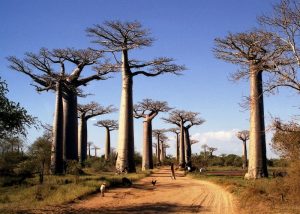
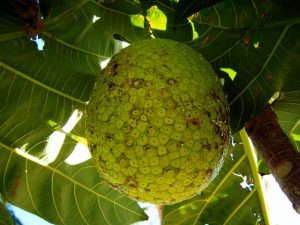 English: Breadfruit
English: Breadfruit
Malagasy: Frampay, Soanambo or Sirapay
Dutch: Broodboom
https://nl.wikipedia.org/wiki/Broodboom_(Moraceae)
https://en.wikipedia.org/wiki/Breadfruit
These fruits are not sweet and have a starchy flesh that becomes soft and potato-like during cooking. They are cheap because there are just a lot of them growing everywhere in the area. They are prepared by cooking them with salt and often eaten as a snack. For larger meals, they are mashed and served with herbs as a side dish (laoka). We don’t like to eat them. Some in our family complained that it causes nausea and stomach pain. I (Jurgen) regularly eat it at people’s homes when I visit. I like it myself. Possibly we do not prepare the fruit properly, I wouldn’t know. I have read that you can also make a kind of french fries with the fruit. That would be quite healthy compared to normal fries because the fruit has a lot of fibres, vitamin C and potassium.
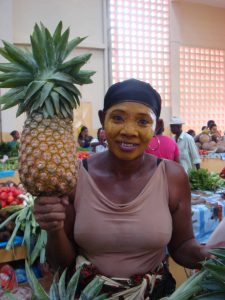 English: Pineapple
English: Pineapple
Malagasy: Mananasy
Dutch: Ananas
https://nl.wikipedia.org/wiki/Ananas
https://en.wikipedia.org/wiki/Pineapple
Delicious! Pineapple is so delicious. They are growing everywhere and we have planted several around the house. Pineapples (just like bananas) taste so much better than what we are used to in the Netherlands. They are not the cheapest fruits on the markets. A large one cost about € 1, -. That is a day’s wages for people in our village. Tourists happily pay double because that is still cheap compared to what pineapples cost in Europe. One day I was chatting to a happy tourist from the Netherlands. He was happy because he had just bought a big Pineapple from that sweet boy for only €2,–. While we were talking that same boy and I made some gestures back and forth. Before the tourist knew what happened I was holding a big Pineapple in my hands. He didn’t quite understand what had happened. In the Netherlands you mainly have to talk, in Madagascar you come a long way with lips gestures, frowning and nodding. I got the Pineapple for the normal Malagasy price, €0,75.
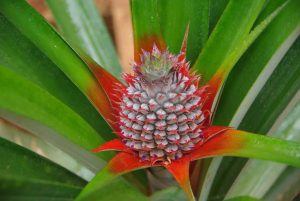
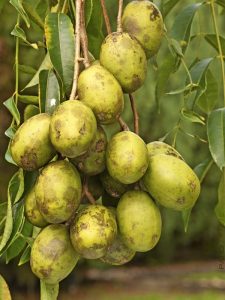 English: June plum of Ambarella
English: June plum of Ambarella
Malagasy: Sakoa of Jovia
Dutch: Ambarella
https://nl.wikipedia.org/wiki/Ambarella
https://en.wikipedia.org/wiki/Spondias_dulcis
We regularly get sellers at the door with these fruits. They cost about €0,05 per three. You have to be careful because they are regularly picked while still unripe and then they are not so tasty. They look a bit ugly from the outside, but the inside has a sweet yellow flesh that surrounds a spiky stone. The taste is a combination of orange and mango. We eat them the way they come, but also on bread or in a salad.
English: Coconut
Malagasy: coco of Voanio
Dutch: Kokosnoot
https://nl.wikipedia.org/wiki/Kokospalm
https://en.wikipedia.org/wiki/Coconut
Coconuts are especially abundant in the coastal towns. They are served with a straw or the juice is poured into a glass. Afterwards the sellers chop the nut further open so you can eat the pulp. In our village there are two trees. They grow in the yard of our friends and so every now and then we get a few of them.
